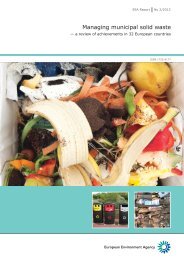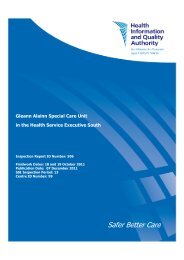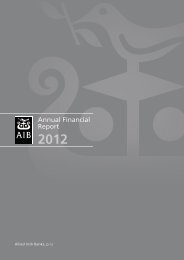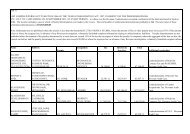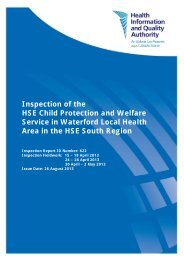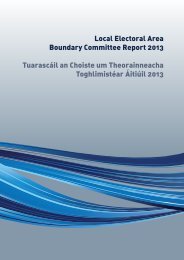HSE Child Protection and Welfare Service in Carlow/Kilkenny - hiqa.ie
HSE Child Protection and Welfare Service in Carlow/Kilkenny - hiqa.ie
HSE Child Protection and Welfare Service in Carlow/Kilkenny - hiqa.ie
Create successful ePaper yourself
Turn your PDF publications into a flip-book with our unique Google optimized e-Paper software.
Inspection of the <strong>HSE</strong> <strong>Child</strong> <strong>Protection</strong> <strong>and</strong> <strong>Welfare</strong> <strong>Service</strong> <strong>in</strong> <strong>Carlow</strong>/<strong>Kilkenny</strong> Local Health Area <strong>in</strong> the<strong>HSE</strong> South RegionHealth Information <strong>and</strong> Quality AuthoritySt<strong>and</strong>ard 2:3 – Timely <strong>and</strong> effective action is taken to protect childrenThis st<strong>and</strong>ard was met <strong>in</strong> partThe duty team leaders prioritised cases us<strong>in</strong>g their own exper<strong>ie</strong>nce rather thanagreed criteria. There was a national prioritisation framework, the <strong>HSE</strong>’s Frameworkfor Measur<strong>in</strong>g the Pressure document, <strong>and</strong> this <strong>in</strong>cluded a prioritisation scale,guidance for the analysis of risk <strong>and</strong> risk assessment questions. Staff were either notaware of or were not implement<strong>in</strong>g this framework. The area manager <strong>and</strong> theact<strong>in</strong>g pr<strong>in</strong>cipal social worker told <strong>in</strong>spectors that the purpose of the framework wasto report on <strong>in</strong>take activity <strong>and</strong> wait<strong>in</strong>g lists. They did not see it as a guide tooperational activity. With<strong>in</strong> this framework there were tools to guide the socialworker, social work team leader <strong>and</strong> act<strong>in</strong>g pr<strong>in</strong>cipal social worker to manage <strong>in</strong>take,assessment <strong>and</strong> allocation activity but these were not <strong>in</strong> use. Rather, decision mak<strong>in</strong>gwas based on the exper<strong>ie</strong>nce <strong>and</strong> skills of the <strong>in</strong>dividual social worker under thedirection of the social work team leader. Whilst staff members were exper<strong>ie</strong>nced, thisapproach was not safe or susta<strong>in</strong>able <strong>in</strong> the medium to long term.There was the possibility that an <strong>in</strong>consistent approach could be taken <strong>in</strong> identify<strong>in</strong>g<strong>and</strong> manag<strong>in</strong>g risk to children. The <strong>HSE</strong> Framework for Measur<strong>in</strong>g the Pressureprovided key pr<strong>in</strong>ciples to guide social workers <strong>in</strong> the consistent application of riskassessment processes, but as stated, this document was not <strong>in</strong> use. Inspectors weretold by social workers that they were guided by the practice notes <strong>in</strong> the <strong>Child</strong><strong>Protection</strong> <strong>and</strong> <strong>Welfare</strong> Practice H<strong>and</strong>book, although it did not conta<strong>in</strong> a riskassessment framework, by their professional knowledge <strong>and</strong> by the advice <strong>and</strong>direction of the social work team leader. Team leaders said that they were <strong>in</strong>formedby their exper<strong>ie</strong>nce <strong>and</strong> <strong>Child</strong>ren First (2011) when prioritis<strong>in</strong>g referrals. Inspectorsfound there was the potential for a number of approaches to be used with<strong>in</strong> thesocial work department <strong>and</strong> this did not lend itself to a consistent <strong>and</strong> agreedapproach to decision mak<strong>in</strong>g <strong>and</strong> prioritisation.Decision mak<strong>in</strong>g was not always timely. With<strong>in</strong> the <strong>HSE</strong> <strong>Child</strong> <strong>Protection</strong> <strong>and</strong> <strong>Welfare</strong>Practice H<strong>and</strong>book, timel<strong>in</strong>es are set out for the screen<strong>in</strong>g of referrals. These shouldtake place, where possible, with<strong>in</strong> 24 hours of be<strong>in</strong>g made. Initial assessmentsshould take place where possible with<strong>in</strong> 20 days follow<strong>in</strong>g the receipt of the referral.Inspectors were told by social workers, <strong>and</strong> found from rev<strong>ie</strong>w of files, that thesetimel<strong>in</strong>es were not always met. Some of the delays were as a result of the way <strong>in</strong>which the duty system was structured. Inspectors were concerned that the outcomefor some children could be poor as critical decisions might be delayed.Inspectors found that there was good quality <strong>in</strong>formation gathered to <strong>in</strong>formdecisions regard<strong>in</strong>g children. The content of the <strong>in</strong>itial assessment process <strong>in</strong> the LHAwas <strong>in</strong> l<strong>in</strong>e with <strong>Child</strong>ren First (2011) <strong>and</strong> this process was <strong>in</strong>tegrated <strong>in</strong>to theelectronic <strong>in</strong>formation system. Inspectors rev<strong>ie</strong>wed files where assessments werecompleted <strong>and</strong> they <strong>in</strong>cluded direct contact with family members, external agenc<strong>ie</strong>s,<strong>and</strong> a range of professionals. There was some evidence that the v<strong>ie</strong>ws of the child,parents <strong>and</strong> carers were sought as part of the assessment. Inspectors also found19





